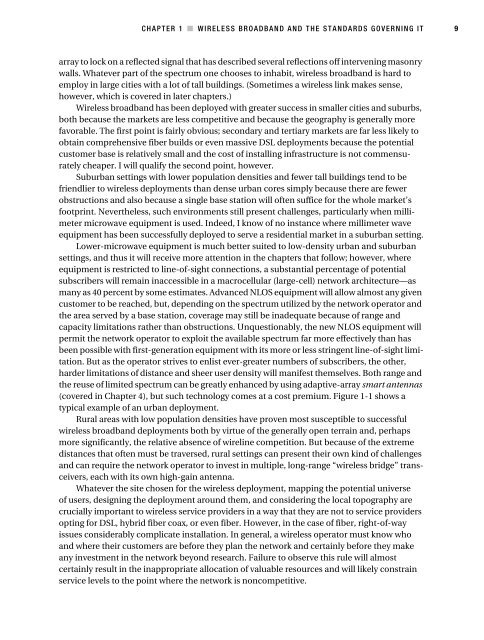WiMax Operator's Manual
WiMax Operator's Manual
WiMax Operator's Manual
Create successful ePaper yourself
Turn your PDF publications into a flip-book with our unique Google optimized e-Paper software.
CHAPTER 1 ■ WIRELESS BROADBAND AND THE STANDARDS GOVERNING IT 9<br />
array to lock on a reflected signal that has described several reflections off intervening masonry<br />
walls. Whatever part of the spectrum one chooses to inhabit, wireless broadband is hard to<br />
employ in large cities with a lot of tall buildings. (Sometimes a wireless link makes sense,<br />
however, which is covered in later chapters.)<br />
Wireless broadband has been deployed with greater success in smaller cities and suburbs,<br />
both because the markets are less competitive and because the geography is generally more<br />
favorable. The first point is fairly obvious; secondary and tertiary markets are far less likely to<br />
obtain comprehensive fiber builds or even massive DSL deployments because the potential<br />
customer base is relatively small and the cost of installing infrastructure is not commensurately<br />
cheaper. I will qualify the second point, however.<br />
Suburban settings with lower population densities and fewer tall buildings tend to be<br />
friendlier to wireless deployments than dense urban cores simply because there are fewer<br />
obstructions and also because a single base station will often suffice for the whole market’s<br />
footprint. Nevertheless, such environments still present challenges, particularly when millimeter<br />
microwave equipment is used. Indeed, I know of no instance where millimeter wave<br />
equipment has been successfully deployed to serve a residential market in a suburban setting.<br />
Lower-microwave equipment is much better suited to low-density urban and suburban<br />
settings, and thus it will receive more attention in the chapters that follow; however, where<br />
equipment is restricted to line-of-sight connections, a substantial percentage of potential<br />
subscribers will remain inaccessible in a macrocellular (large-cell) network architecture—as<br />
many as 40 percent by some estimates. Advanced NLOS equipment will allow almost any given<br />
customer to be reached, but, depending on the spectrum utilized by the network operator and<br />
the area served by a base station, coverage may still be inadequate because of range and<br />
capacity limitations rather than obstructions. Unquestionably, the new NLOS equipment will<br />
permit the network operator to exploit the available spectrum far more effectively than has<br />
been possible with first-generation equipment with its more or less stringent line-of-sight limitation.<br />
But as the operator strives to enlist ever-greater numbers of subscribers, the other,<br />
harder limitations of distance and sheer user density will manifest themselves. Both range and<br />
the reuse of limited spectrum can be greatly enhanced by using adaptive-array smart antennas<br />
(covered in Chapter 4), but such technology comes at a cost premium. Figure 1-1 shows a<br />
typical example of an urban deployment.<br />
Rural areas with low population densities have proven most susceptible to successful<br />
wireless broadband deployments both by virtue of the generally open terrain and, perhaps<br />
more significantly, the relative absence of wireline competition. But because of the extreme<br />
distances that often must be traversed, rural settings can present their own kind of challenges<br />
and can require the network operator to invest in multiple, long-range “wireless bridge” transceivers,<br />
each with its own high-gain antenna.<br />
Whatever the site chosen for the wireless deployment, mapping the potential universe<br />
of users, designing the deployment around them, and considering the local topography are<br />
crucially important to wireless service providers in a way that they are not to service providers<br />
opting for DSL, hybrid fiber coax, or even fiber. However, in the case of fiber, right-of-way<br />
issues considerably complicate installation. In general, a wireless operator must know who<br />
and where their customers are before they plan the network and certainly before they make<br />
any investment in the network beyond research. Failure to observe this rule will almost<br />
certainly result in the inappropriate allocation of valuable resources and will likely constrain<br />
service levels to the point where the network is noncompetitive.
















